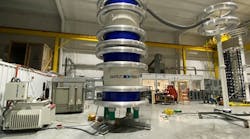More than a dozen major electric utilities are now committing to new voluntary standards to help prevent a major source of blackouts by monitoring their expensive power transformers, Serveron Corporation announced in May.
Because high-reliability power generation and distribution are critical for utilities and their customers, electricity producers and distributors, including the Arizona Public Service subsidiary of Pinnacle West Capital Corporation, are among the organizations now taking this new, yet proven approach. On-site transformer monitoring is helping them watch their transformers more closely, operate them with a greater margin of safety, and manage them to minimize the costs of repairing or replacing these valuable assets.
The voluntary implementation of this new standard practice requires installing advanced, remote monitoring systems on newly installed power transformers, as well as retrofitting existing units. Advanced transformer monitoring – essentially checking a transformer’s insulating oil on-site – has been shown to prevent what utilities call "unplanned failures," through performing dissolved gas analysis (DGA) within these large, complex devices several times each day while they are running.
"We decided to adopt this new standard practice and make on-site, continuous transformer monitoring a regular part of how we operate," said Jan Bennett, vice president of customer service of Arizona Public Service. "It gives us better transformer condition knowledge than previous methods, and the technology and software are reliable. That enables us to use it with all new units, as well as migrate to this standard by retrofitting our critical-use transformers throughout our service area."
According to data published by Hartford Steam Boiler, a major insurer of power generation equipment and facilities, about 1.5% of all large transformers in operation will fail in the next year, and that failure rate is expected to increase.
In the United States alone, that means as many as 1500 of the nation’s more than 100,000 power transformers will go out of service each year in 2006 and beyond, disrupting power and possibly causing damage and human injury from explosion and fire. Estimates are for that figure to continue to increase during the next ten years, reflecting the advancing age of the nation’s transformer fleet, the average of which today is about 40 years old and increasingly prone to failure based on predicted design life.
Before adopting this new standard practice, utilities typically tested for gases present inside a transformer’s tank by drawing a once- or twice-yearly sample of its insulating oil, sending it off-site to a laboratory, and reviewing the results when the report became available a week or so later.
Some utilities perform DGA testing more often, especially if a unit has been affected by a "through fault" (e.g., lightning). Some already have limited-value monitors connected to their transformers that can indicate a problem but not diagnose it. As with a smoke detector in a home, the alarm is inconclusive, unable to distinguish between the equivalent of burnt toast or a real fire.
The systems installed under the new standard – including Serveron’s Transformer Monitor Model TM8 – look for and measure how much acetylene (C2H2), carbon dioxide (CO2), carbon monoxide (CO), ethane (C2H6), ethylene (C2H4), hydrogen (H2), methane (CH4), and oxygen (O2) are present. The test results, if there is danger detected, provide insight into whether or not the transformer – which is essential to reliable electric energy transmission, and can cost from $1 million to $6 million or more – should be shut down, run with reduced load, overhauled, repaired or replaced.
"Accordingly, this new standard helps utilities make much better decisions regarding the reliability and usage of their transformer fleets," said Bart Tichelman, president and chief executive officer of Serveron. "That enables them to stretch their limited capital expenditure, operating and maintenance budgets while preventing avoidable power outages and their attendant problems."
Serveron’s gas chromatography technology reliably correlates DGA data to external events and has facilitated the prevention of many transformer failures. Serveron also produces a three-gas model, the Model TM3, which is a cost-effective solution for smaller transformers and supports the new standard.

